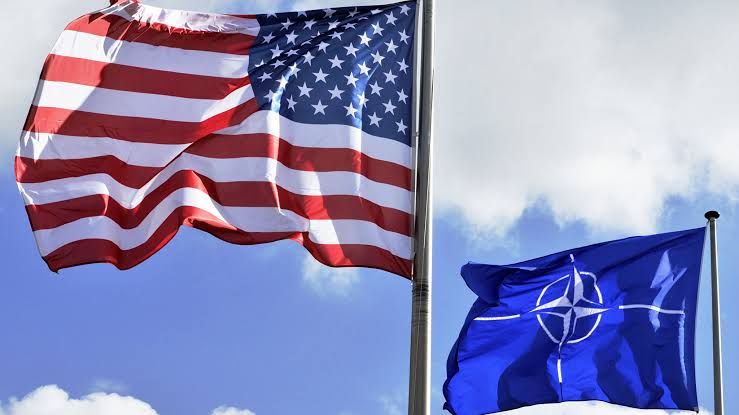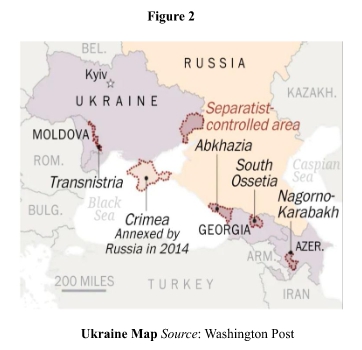NATO, Europe, and Ukraine: American Imperialism and Its Geopolitical Turn

Illustration. Photo by Getty Images
Think hard about it. I’m running of demons. I’m running out of villains.
—General Colin Powell
In the mainstream IR thought, NATO has always been described as the passive alliance which fundamentally aims to contain the increasing influence and movement of Soviet Union. Both two grand paradigms of IR in the time of Cold War, realism and liberalism, explained NATO origin and main motive are strategic balancing toward Soviet Union or defending liberalism and democracy from the threat of socialism and authoritarianism (Gowan, 1999b, p.71-72). Consequently, as the Cold war ended, according to this paradigm, NATO should have collapsed. However, NATO remains in existence and even reoriented its purpose of existence. It is said that NATO will become a liberal norm-based collective security regime. Nevertheless, its maneuver on Eastern Europe, especially in Kosovo and Yugoslavia, was arguably the most geopolitical one (Gowan, 2000). Thus, the continued existence of NATO has something other than enemy threat to security or values or power balancing (Gowan, 1999b, p.74). In other words, NATO has not been what the realists or liberals have thought it was about.
NATO and America Imperialism: Revisiting Peter Gowan Conceptualization
In order to understand the real drive behind NATO continued existence and its maneuvers, alternative explanations should be proposed. This article argues that capitalism and geopolitical drive play a significant role in NATO’s continued existence and its maneuvers. On this particular issue, this article will use Peter Gowan conceptualization on American imperialism and its three pillars is the best conceptual tool to calculate the capitalist and geopolitical aspect of NATO maneuver.
For the starting point, it is central to briefly explain how Gowan explains American imperialism. Gowan define American imperialism loosely as a world order which is designed to put America as the hegemon (Sakellaropoulos and Sotiris, 2009). The systemic drive of American imperialism is compelled by its capitalist class expansion which practically facilitated by the state (Gowan, 2009b). Consequently, the main drive for the domination is not compelled by anarchic conditions or survival efforts of a great power, but the structural consequences from the development of American capitalism and its drive to expand globally (Gowan, 2009a). Furthermore, American imperialism, in contrast with Britain imperialism, still maintains the plurality of the states and their autonomy as well (Gowan, 2002a). In other words, American world order purposively maintains the Westphalian system of sovereign states.
In creating this kind of imperialism, America established three crucial pillars as the structure, namely dollar and Wall Street regime (economy), NATO and the condition of security dependence for the advanced capitalist states (geopolitics), and universal moral value as the justification tools for the American dominance (Pijl, 2003; Gowan, 2004). All of these pillars were created in the Cold War era.
Further explanation on these three pillars will only be focused on the geopolitics pillar which refers to the condition of security dependence for the advanced capitalist state. In creating this condition, America is supported and benefited from its industrial military dominance after World War II, the rise of Soviet Union, and its triumph in the second world war (Gowan, 2004). In Asia, America forced Japan to sign a United States-Japanese Security Treaty 1951 which obstructed Japan’s capacity to build its military and at the same time grant America access to Japan territory. Meanwhile, in Europe, the creation of NATO, though involving most of the great power states in Europe, also grants America similar conditions like in Japan (Gowan, 2004).
In this context, how NATO could give America a privilege as a hegemonic actor is a material and political matter. Materially, America has an overwhelming military capacity and leadership in NATO (Gowan, 1999b, p.74). Meanwhile, politically, NATO is the institutional form of American political sovereignty toward Western states. In this case, political sovereignty refers to Carl Schmitt definition. First, his concept of politics was that of enemy-friend relations. Political action thus consists of developing capacity to decide who their friends are (and thus who they are) and who their enemies are (and thus also who they are) (Gowan, 1999b, p.76). In the time of Cold War era, America had this specific capacity and consequently places NATO under his leadership. Second, the most crucial one, Schmitt also defines the sovereign as he who can decide the state of emergency. Capacity to decide the state of emergency means what kind of situation that should be respond by NATO and one that should not. One example from this could be seen in the case of NATO’s involvement in Iraq invasion toward Kuwait in 1991 (which, of course, dominantly determined by US) and the renouncement of French maneuver to use NATO in invading Algeria (Gowan, 1999b, p.77). Both of these capacities are the main feature of American hegemony in NATO.
The End of Cold War and The Problem of NATO’s Existence
When the Cold War came to an end, the geopolitical structure of American imperialism faced a systemic crisis which refers to legitimation and material issue. The end of Cold War could give an end of the continued existence of NATO which is crucial for American imperialism. However, the case is more than just justification. Instead of that, it is fundamentally material. The most threatening issue for America is the possibility of European independence in the security realm (Gowan, 1999). Historically, this possibility could be realized by political maneuver from Germany, France, and Russia. When Russia decided to end the Cold War, Gorbachev, the President of Soviet Union at that time, proposed One Europe as a strategic vision which could give Europe autonomy. This vision could fundamentally remove American hegemony in Europe (Cafruny, 2003). Meanwhile, Germany and France which planned to create an independent European Union military which ground on Europe normative value start to emerge (Cafruny and Ryner, 2017, p.186). As the logical consequence, NATO will be fundamentally delegitimized and American hegemony toward Europe will cease to exist.
On this exact point, NATO’s continued existence and all of NATO maneuver in East Europe and later on Ukraine should be understood. Thus, in other words, the main logic of NATO’s eastward expansion is basically a response toward the possible destruction of its imperialism geopolitical pillar. On American Defense Planning Guidance in 1992, the reflection of the real drive of NATO was stated explicitly,
“…We must seek to prevent the emergence of Europe-only security arrangements which would undermine NATO, particularly the alliance’s integrated command structure… We must maintain the mechanisms for deterring potential competitors from even aspiring to a larger or global role,” (Gibbs, 2001).
Historically, to achieve those substantial purposes, the initial maneuver of America was a transformation of NATO’s role which conduct by geographical expansion and the changing role of NATO as an offensive strategic alliance who can operate outside of its member territory (Gowan, 2000). First, in the context of geographical expansion, NATO managed to include Poland, Czech Republic, and Hungary as its member. The requirements for the membership were easy and only oblige the new member to involve in security issue and grant NATO access to establish military base to their territory (Kastrati, 2014). With this maneuver, America could get an access to prevent further advancement of Russia-Germany relations and at the same time giving America capacity to decide the future of relations between Russia and Europe (Gowan, 1999b, p.90). The strategic location of those three East European states becomes crucial factor to realize those purposes.
Second, on the changing role of NATO, the Yugoslavia war and the Kosovo tragedy are examples of this maneuver. Yugoslavia and Serbia were being accused to do a genocide and for this reason America, through NATO, conducted a rescue mission by using an advanced air force technology (Gowan, 1999b, p.91). Practically, this maneuver was not only to prevent genocide to happen again on European soil. Rather, this maneuver aims to restore American hegemony in Europe. First, it gave a new role for NATO to operate beyond its member’s territory (Gowan, 2000). Second, it shows European states that any use of force could only be done legitimately through NATO (Gowan, 1999b, p.93). Consequently, this case grants America control over security sector in European Union.

NATO Expansion in toward Ukraine: A Geopolitical Turn of American Imperialism
However, in spite of its success to restore the geopolitics pillar, all of America’s maneuver could not recreate a total dependency of Western Europe states just like in the Cold War time. There are two reasons for this condition. First, advanced capitalist states in the West were not putting full political authority on NATO. In this context, NATO was forced to only operate under the approval of the UN Security Council. Central to this case is the possibility of bringing back Russia in European politics through the UN and creating a chance for advancement of Europe-Russia relations, specifically Germany-Russia, in UN (Gowan, 1999b, p.99). This was becoming more frustrating because of the fact that it is legal and America could do nothing about it. Second, NATO still lost its legitimacy for ensuring the EU will be totally dependent on its combat power (Gowan, 1999b, p.100). There are no real enemies and possible threats that could be used to justify NATO existence. Thus, right on this point, Colin Powell, the former general of NATO, words in the beginning of this section should be understood in this context.
Both of these conditions are the background of NATO eastward expansion in the 21st century. NATO expansion is driven by geopolitical turn to consolidate its hegemony in Europe. The case of Ukraine is no different. NATO expansion toward Ukraine was realized through geographical expansion which at length offers Ukraine a membership of NATO through Partnership for Peace mechanism. What is interesting here is the fact that Ukraine’s membership will absorb NATO’s funds. This was due to the small national income of Ukraine, that would consequently increase NATO military fund (Menon and Ruger, 2020). This could be depicted as a sincere motive from NATO to spread democracy and to defend Ukraine sovereignty. However, historically, this kind of narratives has been proved to be misleading and even now, some of NATO members in Eastern Europe, such Poland and Hungary, can be considered illiberal (Menon and Ruger, 2020). Thus, the only possible and rational reason for NATO’s eastward expansion, especially in Ukraine, is about the consolidation of American imperialism in Europe. In order to understand this argument, the strategic position of Ukraine should be understood.

Ukraine’s position for the consolidation of American imperialism should be understood on its strategic geographic location which links Russia and Western Europe (Gowan, 2002b, p.48). Incorporating Ukraine in NATO will give America advantages in the economy and geopolitical realm. Geopolitically, this could prevent any further attempt to strengthen Russia-Germany relations or any Russian attempt to gain a hegemony over Eastern Europe (Gowan, 2002b, p.50). Meanwhile, economically, since Ukraine is the dominant pipeline that links Russian gas to Europe, America also will gain control over the future of Europe’s energy security. This will directly put Europe under American security policy and at the same time replaced Russian domination over gas supplies for Europe.
Another geopolitical maneuvers that could also happen is a closer China-Europe relations through the Belt and Road Initiative and the financial cooperation with Asian Development bank (Martin and Sinkkonen, 2022). NATO maneuver on Ukraine will give America the assurance that Europe will not be a potential existential threat when it focuses on Asia Pacific which aims to contain Chinese maneuvers. Hence, it is totally unconvincing and abstruse to declare that America, with or without NATO, is promoting democracy or defending any human rights in Ukraine. In fact, since the start of the Crimean conflict in 2014, any peace agreement attempt between Ukraine and Russia was failed by America (Watkins, 2022). NATO has always supplied Ukraine with arms and helped it start to build its military base. At the present time, Ukraine might not be in NATO, but NATO was and will be in Ukraine (Watkins, 2022).
Conclusion
Since the Russian invasion of Ukraine started in early 2022, we have witnessed varying perspectives that has tried to explain what caused the Russian policy to be so aggressive. Many scholars have tried to point out either the domestic drive of the Russian government or the eastward expansion of Western states as the main cause. However, IR approaches mostly fail to ask a basic question such as “what is NATO?” and “why does it continue to exist?”
The consequences of these neglects are crucial. Later on, most of them come up with a certain false assumption that obscures their argumentation of NATO. Liberalism argues that NATO’s eastward expansion is driven with a moral purpose, such as spreading the value of democracy. Realism argues the same basic point but comes up with a different interpretation, where they curse its action as something illogical (balance of power); in other words, realism actually doesn’t have any realist argument about what drives NATO to expand eastward.
This article has prove that the real drive of NATO eastward expansion, including to Ukraine, as something that is strongly connected to the logic of American imperialism. As a result, any other arguments that regard NATO’s action as a moralistic policy with a just purpose to protect Ukraine or to spread democracy are nothing but parroting of American propaganda.
Furthermore, with this theoretical explanation, a more radical political stance could be proposed. We could strongly reject the involvement of NATO in this conflict because they do not come to bring peace or democracy. They come with an imperialist agenda. Saying this kind of political stance, as I am also aware of, people will assume that I implicitly suggest people to support Russia to do as it pleases. However, it is totally a different case. Russia’s policy certainly aims to colonize and dominate Ukraine and we surely need to reject it as well. To have an understanding about American imperialism means we do not naively think and support NATO or American rhetoric about the spreading of democracy or defending independence of Ukraine.
References
Cafruny, A. W. (2003) “The Geopolitics ol U.S. Hegemony in Europe: From the Breakup of Yugoslavia to the War in Iraq,” in Cafruny, A. W. and Ryner, J. M. (eds.) The Ruined Fortress: Neoliberal Hegemony and Transformation in Europe. 1st ed. United States of America: Rowman & Littlefield, pp. 95–122. Available at: https://medium.com/@arifwicaksanaa/pengertian-use-case-a7e576e1b6bf.
Cafruny, A. W. and Ryner, M. (2017) The European Union and Global Capitalism: Origins. Development, and Crisis. 1st ed, Palgrave Pacmillan. 1st ed. Edited by N. Nugent and William Paterson. United Kingdom: Palgrave Macmillan UK. Available at: https://medium.com/@arifwicaksanaa/pengertian-use-case-a7e576e1b6bf.
Gibbs, D. N. (2001) Washington’s New Interventionism: U.S. Hegemony and Inter-Imperialist Rivalries, Monthly Review. doi: 10.14452/mr-053-04-2001-08_2.
Gowan, P. (1999) The Twisted Road to Kosovo. 1st ed. Edited by G. Fagan. England: Labor Focus on Eastern Europes.
Gowan, P. (2000) “Making Sense of NATO’s War on Yugoslavia,” Socialist Register, 36(March 1998), pp. 1–27.
Gowan, P. (2002a) “A Calculus of Power,” New Left Review, (16), pp. 47–67.
Gowan, P. (2002b) “The EU and Eastern Europe: Diversity without Unity?,” in Fella, M., Stefano, F., and Newman, M. (eds.) European Integration in 21st Century. London: SAGE Publications, pp. 29–49.
Gowan, P. (2004) “Contemporary Intra-Core Relations and World Systems Theory,” Journal of World-Systems Research, pp. 471–500. doi: 10.5195/jwsr.2004.291.
Gowan, P. (2009a) “Crisis in the Heartland: Consequences of the New Wall Street System,” New Left Review, 55, pp. 5–29. Available at: http://www.scielo.br/scielo.php?pid=S0103-40142009000100004&script=sci_arttext&tlng=es.
Gowan, P. (2009b) “The Ways of the World,” New Left Review, pp. 51–70.
Kastrati, M. B. (2014) “Similarities and Differences between NATO and the EU Enlargement,” ILIRIA International Review, 4(2), p. 205. doi: 10.21113/iir.v4i2.45.
Martin, G. and Sinkkonen, V. (2022) “Past as Prologue? The United States and European Strategic Autonomy in the Biden Era,” European Foreign Affairs Review, 27, pp. 99–120. doi: 10.54648/EERR2022013.
Menon, R. and Ruger, W. (2020) “NATO Enlargement and US Grand Strategy: a Net Assessment,” International Politics, 57(3), pp. 371–400. doi: 10.1057/s41311-020-00235-7.
Pijl, K. Van der (2003) “The Global Gamble: Washington’s Faustian Bid for World Dominance and Global Social Policy,” Historical Materialism, 11(3), pp. 201–213. Available at: http://scholar.google.com/scholar?hl=en&btnG=Search&q=intitle:The+global+gamble:+Washington’s+Faustian+Bid+for+World+Dominance#9.
Sakellaropoulos, S. and Sotiris, P. (2009) “Peter Gowan’s Theorization of the Forms and Contradictions of US Supremacy:,” Cultural Logic: A Journal of Marxist Theory & Practice, 16, pp. 1–32.
Watkins, S. (2022) An Avoidable War?, New Left Review.
Nandito Oktaviano is a graduate student of IR in Hasanuddin University. He can be reached at ditoguntur10@gmail.com








